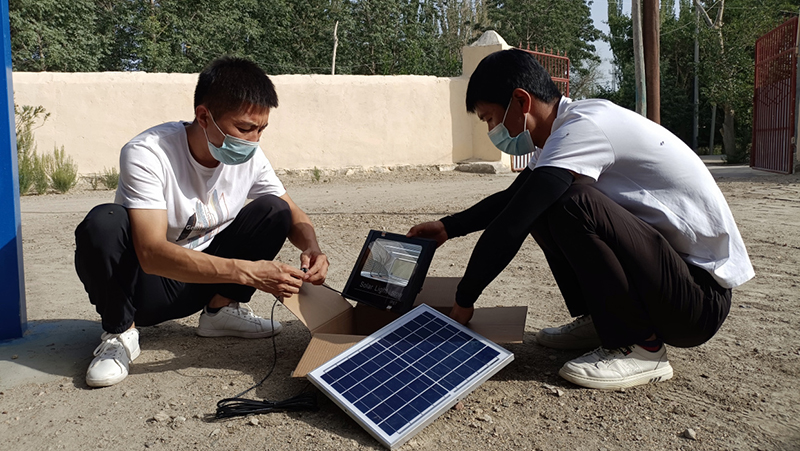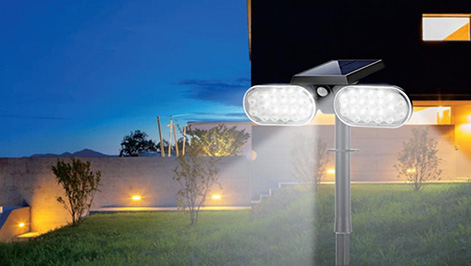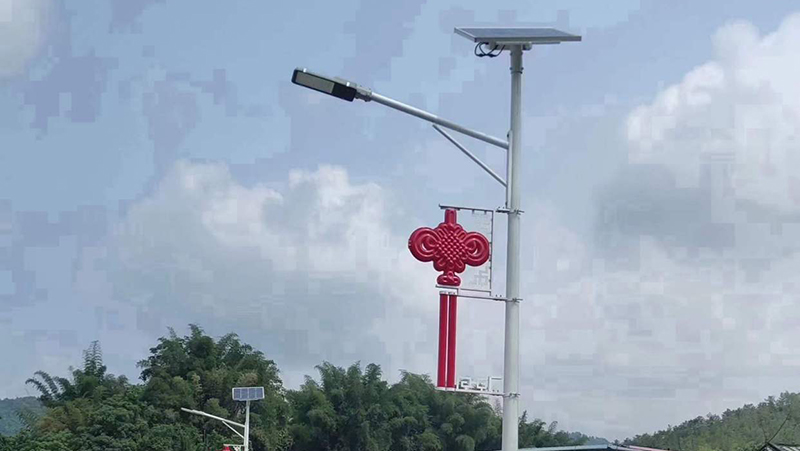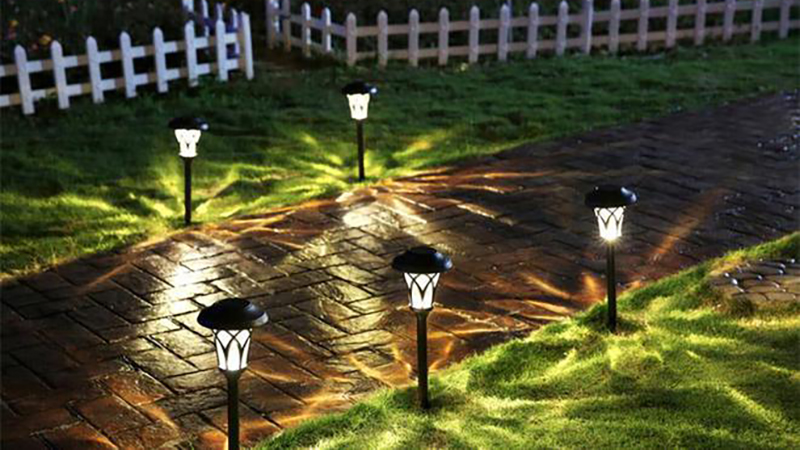A complete solar lawn lamp system includes: light source, controller, battery, solar cell module, and lamp body. During the day, solar cell modules convert light energy into electrical energy and store it in a battery through a controller. At night, the battery supplies power to the light source through the controller, converting it into light energy for lighting decoration. The lamp body mainly serves as a system protection and decoration during the day, ensuring the normal operation of this cycle.
The light source, controller, and battery are the key factors that determine the performance of the lawn lamp system, and they must be optimized and configured reasonably in the design.
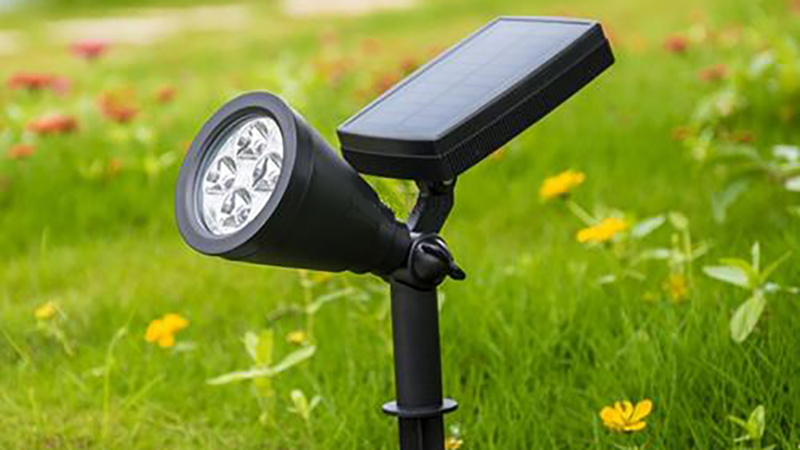
1. Light source
Due to component power limitations, solar lawn lamps must have very low light source power, ranging from a few watts to a few watts, with more being 0.5W and 1W. At present, some solar lawn lamps use energy-saving lamps as the light source. The light efficiency of ordinary energy-saving lamps is about 40-50 Lm/w, while the light efficiency of LED lamps has reached 90 Lm/w. In the laboratory It has reached over 120Lm/w, and under the same illumination, LED lamps can save more than 40% electricity compared to ordinary fluorescent lamps, with relatively high conversion efficiency.
In addition, in terms of service life, ordinary fluorescent lamps have a lifespan of 3000-5000 hours, while LED lamps have a theoretical lifespan of about 100000 hours when the light decay reaches 70%. The actual lifespan can reach 50000 hours, which is more than 10 times that of ordinary fluorescent lamps. If a lamp works for 8 hours per day, it can last for 6250 days, so there is no need to replace it frequently, which can greatly save maintenance costs. LED lights are known as green lighting sources, which do not contain toxic and harmful substances (such as mercury), avoiding secondary pollution caused by the rupture of fluorescent tubes and the spillage of mercury. At the same time, LED lights are driven by a constant DC current, which does not produce any flicker or interfere with radiation, and is not harmful to human health; When the Color index is above 80, the color of objects under light is more realistic and colorful.
Therefore, LED is very suitable for solar lawn light systems. In LED applications, the main issues are constant current and heat dissipation. Although many solar lawn lamps have already adopted LEDs, these problems have not been solved very well. In terms of constant current, the characteristics of LEDs are similar to those of ordinary diodes. When the voltage changes very little, the current may vary greatly. For example, when the working voltage changes by 0.1V, the working current may change by about 20mA. In order to achieve constant current and prevent excessive working current, many lawn lamps use series current limiting resistors, but the significant energy loss is clearly not suitable for solar lawn lamps with already limited power generation. At this point, constant current circuits can be designed. There are many ready-made constant current chips specifically developed for LED, which can be combined with LED to achieve good constant current effect without the need for complex peripheral circuits, effectively protecting LED and extending its lifespan.
In high-power LED applications, heat dissipation is another major consideration. Poor heat dissipation can cause serious light attenuation, which may decrease to half of the original value within six months. In lawn lamps, high-power LEDs are mostly single applications, and can be fully utilized using conventional aluminum substrates. The impact of this aspect is generally not significant, but it also needs to be verified through experiments.
2. Selection of battery
In recent years, solar lawn lamps on the market generally use a system consisting of Lead–acid battery or nickel hydrogen batteries and LED lamps.
During use, lead-acid batteries require acid replenishment, which requires a lot of maintenance work. At the same time, the overflow of sulfuric acid electrolyte may damage the lamp body or other public facilities. In addition, the specific energy of Lead–acid battery and nickel hydrogen battery is small. As for the commonly used 4Ah battery, its volume and weight are large, and the setting and installation of system electrical components occupy a large space, which is not conducive to the flexible design of the lamp body structure.
Lithium ion battery is a new type of high-energy battery developed in the 20th century. It has a high energy density. Under the same capacity, its weight is half of that of nickel hydrogen battery, 30% of that of Lead–acid battery, and its volume is 20-30% of that of Lead–acid battery and nickel hydrogen battery. And the discharge platform of lithium-ion batteries is 3.7V, and the charging voltage of solar cell modules is 6V. Compared to the discharge platform of lead-acid batteries with 12V, the charging voltage of battery modules is 17V, which can reduce the number of scratches for 2/3 of the battery cells, reduce waste, and improve the utilization rate of the battery cells.
Lithium ion batteries have a long cycle life, and under normal conditions, their charging and discharging cycles can exceed 500 times. In sunny weather, the solar cell module will continuously charge the battery, while only consuming about 25% of the battery capacity at night. At this time, the battery will be in a continuous floating charge state, which can greatly extend its service life. Lithium ion batteries do not contain metal substances such as cadmium, lead, and mercury that are harmful to the environment, and do not contain highly reactive metal lithium with chemical properties. They can be guaranteed and comply with the design concept of green and environmentally friendly solar products.
3. Design of controller
Due to the instability of the power generation of solar cell modules, which varies with weather conditions and sunlight duration, the charging and discharging control of batteries in solar photovoltaic independent power generation systems is more complex than in ordinary applications. The design of the controller directly determines whether the entire solar lawn light system can operate smoothly.
A complete solar lawn light controller should have two functions: It is a functional control. Lawn lights are used for lawn decoration during the day and as decorative lighting at night. Depending on different usage situations, some require working all night, while others require working for 4-8 hours. Therefore, there must be functions of light control on, light control off, or light control on, time control off.
4.On the other hand, it is the control of protection functions.
Including anti backlash protection for solar cell components, overcharging protection for batteries, over discharge protection, temperature compensation function, constant current drive for LEDs, etc. The function of preventing reverse charging is usually achieved by connecting a diode in series in the charging circuit of a solar cell. The diode prevents reverse charging, and Schottky diodes are often used. The voltage drop of Schottky diodes is lower than that of ordinary diodes.
For solar lawn lamps, many lithium-ion batteries come with protective panels to prevent overcharging and over discharge. However, in controller design, these functions do not need to be added. If there is no protective board, these functions must be added to the controller, as excessive discharge of many batteries can cause Sexual damage. So it should be determined based on the usage situation, and the discharge cut-off voltage should not be too low.
The constant current drive of LED is mainly achieved by adjusting the input current of the LED through a boost circuit or combining it with a dedicated constant current chip, so that it can still maintain constant current drive of the LED even when the battery voltage is constantly changing.
5. Other aspects
Setting the light source to flicker can not only make the solar lawn lamp emit dynamic light, but also reduce the average output current of the battery by changing the flicker duty cycle, extending the system's working time. At the same time, setting the lawn lamp to time controlled should not be set to stay on all night, causing excessive waste, or reducing the power of the solar cell module and the capacity of the battery, reducing costs.
Packaging form of solar cells. At present, there are two main packaging forms for solar cells, lamination and encapsulation. The use of a laminating machine for laminating can make the working life of the solar cell module reach more than 25 years. Although the appearance of the potting adhesive can be made very beautiful, because the aging resistance of the potting adhesive is very poor, it is easy to turn yellow or delaminate and fall off, which seriously reduces the power generation efficiency or can not be used. It is directly placed in the outdoor sun, and its working life is only 1-2 years.
Therefore, for small and low-power solar lawn lamps for household use, sealing adhesive can be used for encapsulation when there is no lifespan requirement, while for solar lawn lamps that are used in formal occasions and have a specified lifespan, laminated encapsulation must be used.
